There are so many delicious Colombian fruit exported abroad, but there is nothing like eating them where they grew.
I have so many incredible memories from traveling Colombia – first of all dancing salsa every night in Cali. Traveling in the gorgeous coffee region and how Colombians are SO friendly it actually scared me at first!
But the first thing that comes to mind about this underrated country is all of the fruits in Colombia.
One of my favourite things to do in Colombian towns was to go to the market. There would be rows of juice vendors selling fruit juices I had never seen before!
And so while of course I loved Colombian food, the thing that brings a smile to my face is all of these new flavours.
PLANNING A TRIP TO COLOMBIA?
Colombian Food
Colombian Slang Survival Guide
Best Museums in Bogota
23 Delicious Drinks in Colombia
Incredible Colombian Fruit
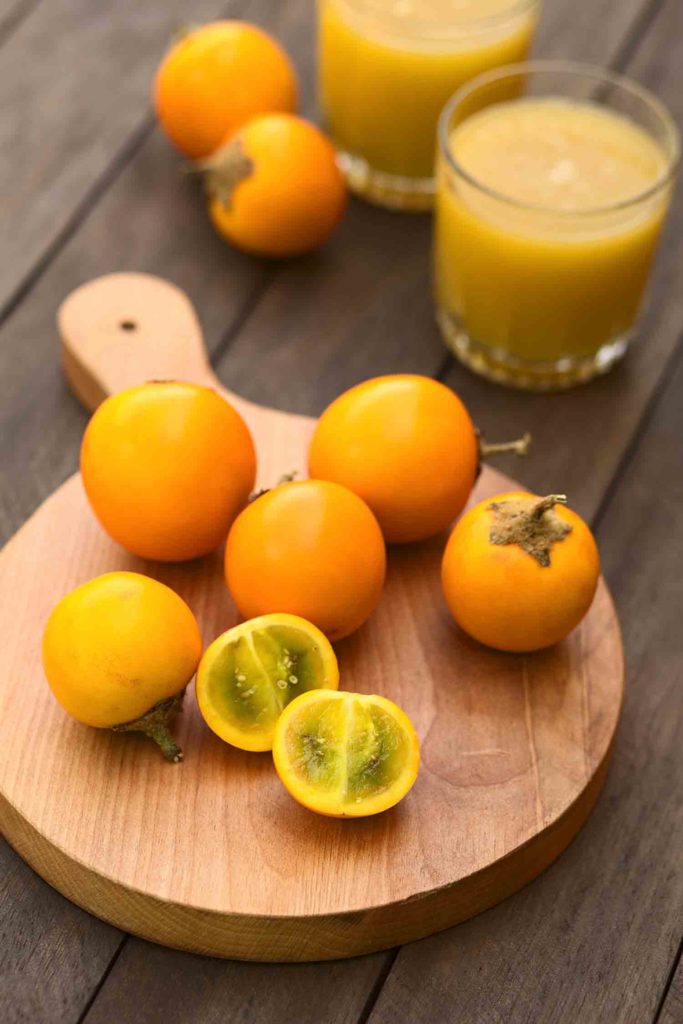
Lulo
It is known as naranjilla or little orange. Lulo is one of the fruits in Colombia that’s used widely for its rich flavor and high nutritional content.
The fruit traces its history back to Colombia and Ecuador. Here it’s still widely grown today in four varieties: thorny, smooth, purple and jungle.
Harvest season that runs from September to November. Lulo is left to ripen for a week so it becomes soft and juicy.
Colombian Breakfast Foods
Although mostly eaten raw and salted, this fruit is also commonly used for juicing or made into sauces, jellies and jams.
Lulo’s pulp is also combined with other tropical fruits for ice cream or sorbets. Colombians add it into a popular drink called lulada.
It’s also widely cultivated in Ecuador. It’s one of the most common Costa Rican fruit along with Panama and one of the most popular fruit in Hawaii.
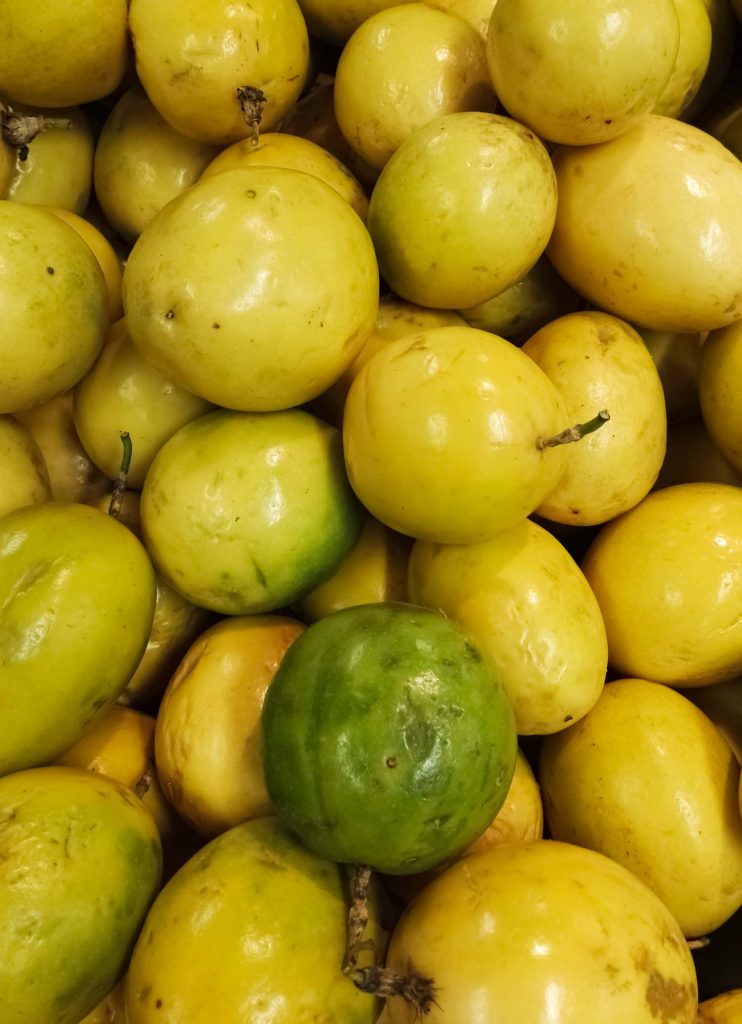
Maracuya
It’s called parcha in Puerto Rico, pasionara in Paraguay and maracuja in Brazil, but maracuya is more commonly known to us as passion fruit.
It is considered one of Colombia’s exotic tropical fruits. It is widely grown all over Latin America. And it’s known for its bright yellow skin and pungent aroma when fully ripe.
21 Most Exotic Fruits Around the World
Maracuya is available in Colombian markets for most of the year and aside from being eaten raw.
It is also used for juices, ice cream and jams because of its sweet and almost tart flavor.
Maracuya is also one of the Colombian fruits commonly used in Colombian cuisine. It is a sauce to pair with chicken, pork or salmon, or as the main ingredient of the popular dessert postre de maracuya.
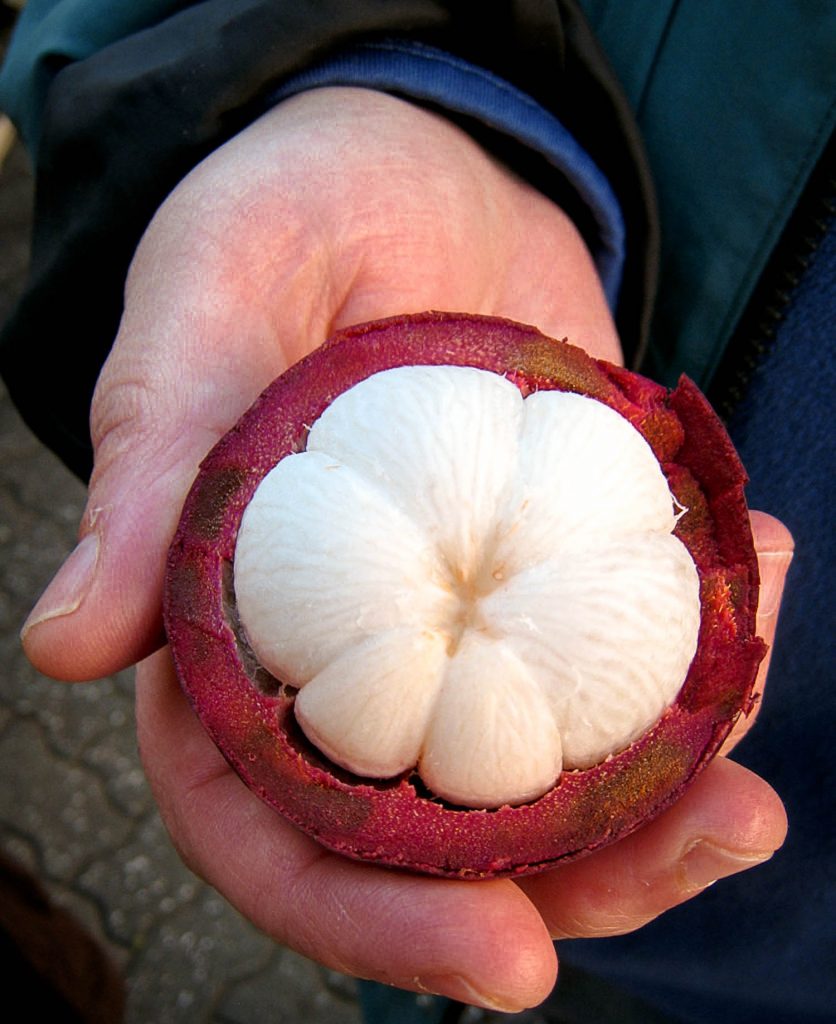
Mangostino
Mangostino or mangosteen is known around the world for its health benefits. But in Colombia, it is mainly enjoyed for its sweet and tangy flavor.
Native to Southeast Asia, it’s a very popular fruit from Vietnam, mangostino was introduced in the tropical parts of Latin America like Colombia.
Today it is now grown widely and exported all over the world.
Mangostino has a distinct purple outer shell and its flesh resembles that of citrus fruits with its individual pulps.
Harvest season in Colombia runs from November to February and July to August. During this time you’ll find an abundance of mangostino around the country’s local markets.
As a bestselling fruit in Colombia, mangostino is not only eaten raw but it’s also used for juices, smoothies and desserts.
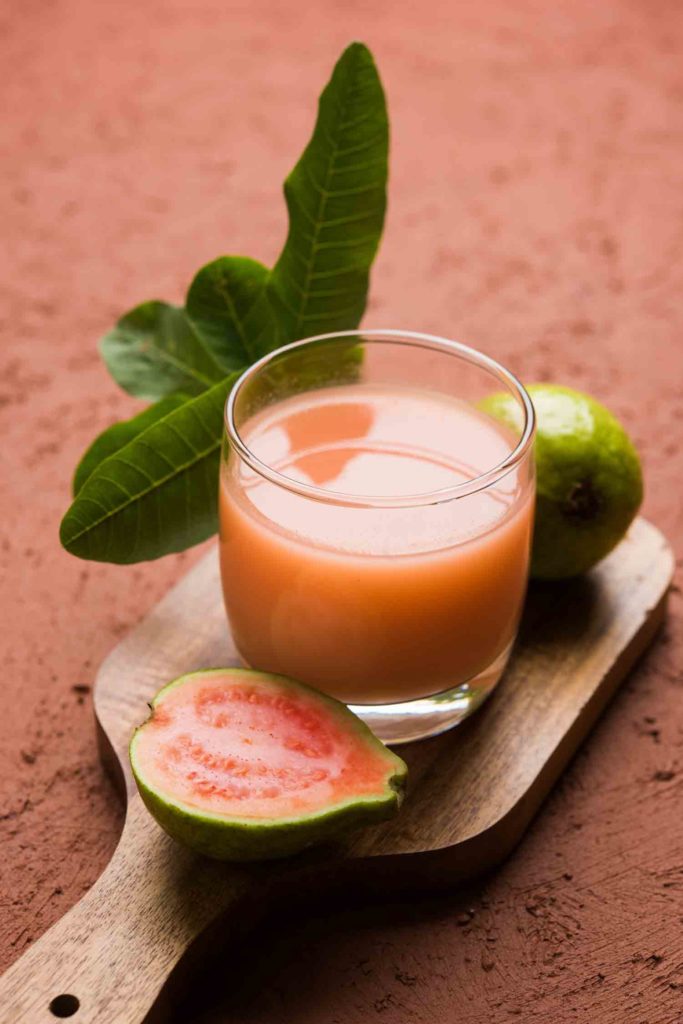
Guayaba
Widely known as guava, guayaba is a green fruit with a pink flesh. It is native to northern South America, Central America and the Caribbean.
Colombians also use guayaba in different preparations, especially as bocadillo or guava paste that’s added to different Colombian dishes.
It’s also one of the most popular Cuban fruit.
This paste is made by combining the ripe guava pulp and sugar that’s cooked slowly and formed into a block.
Guayaba is also used for juices, smoothies and as flavoring for ice cream and sorbets.
This fruit contains vitamin C, dietary fiber and folic acid. It is usually salted and eaten raw for its sweet and tart flavor profile.
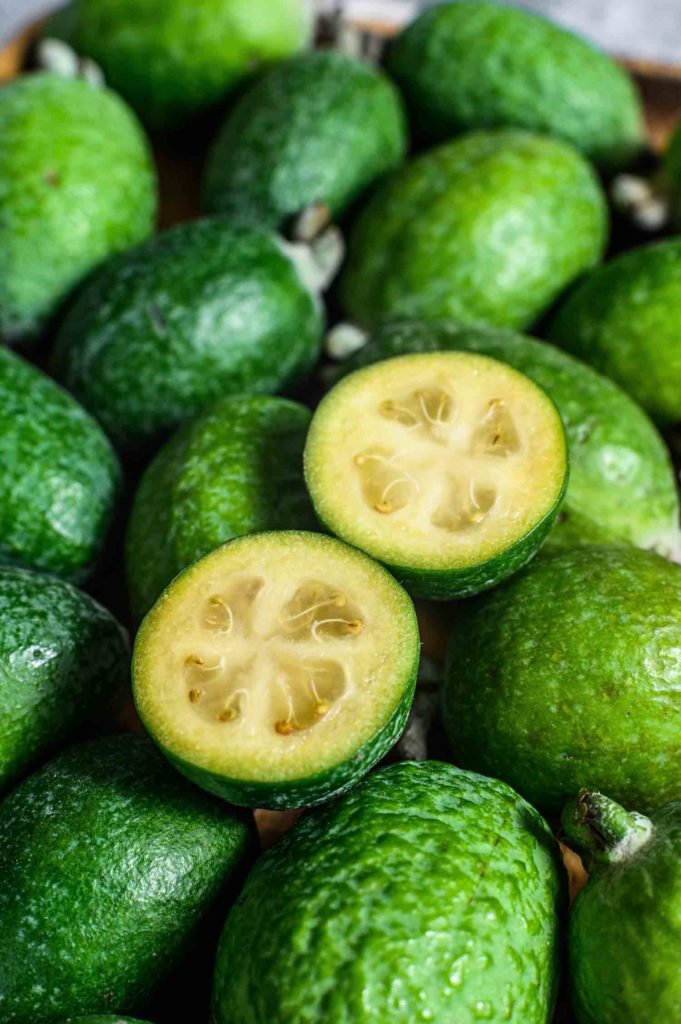
Feijoa
This may be the first time you’ve heard of feijoa, but this fruit in Colombia is so highly revered that every June, the town of Tibasosa celebrates the feijoa festival to honor this fruit.
Native to southern Brazil, feijoa found its way to Boyaca, Santander, Cundinamarca and Valle del Cauca in Colombia. Here it’s been cultivated for centuries.
Feijoa is about the size of an egg with a green, wrinkled exterior. Since it doesn’t change color even when ripe, you’ll need to squeeze the feijoa to know if it’s ready to eat.
The fruit’s flesh is usually sweet and a bit tart. And you have to eat it within 3 days after it has ripened. Aside from being eaten raw, feijoa is also used for pastries, ice cream, jellies, candies and cookies.
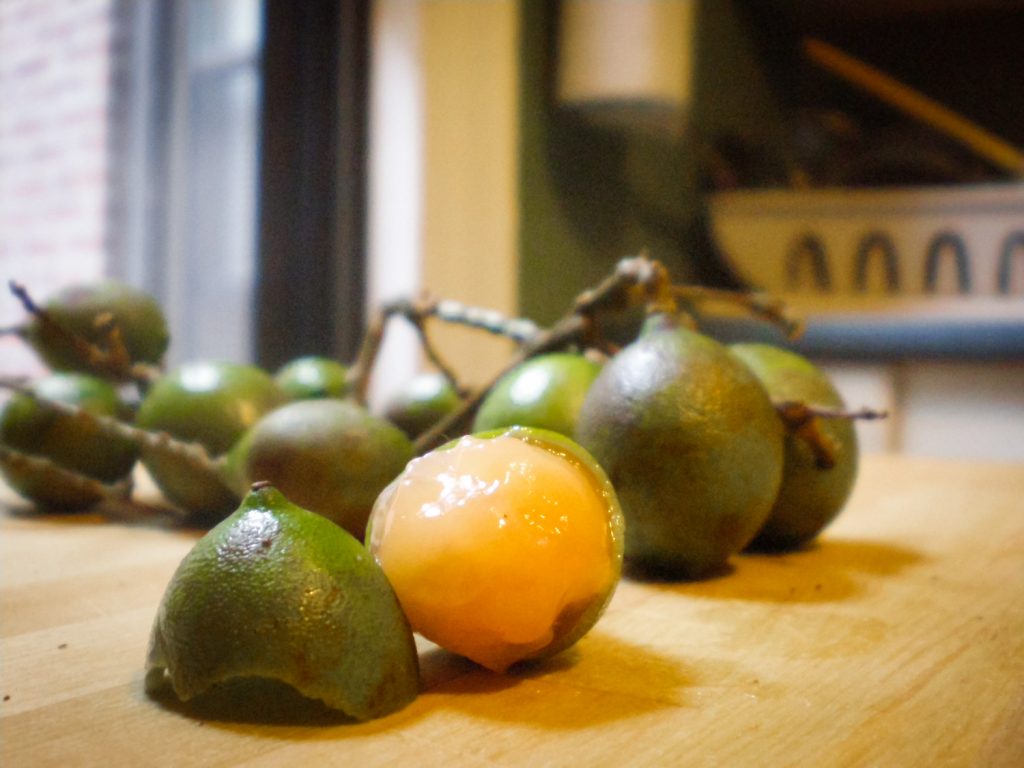
Mamoncillo
Although they are known as Spanish limes, mamoncillo is one of the native fruits in Colombia and Venezuela that’s eaten by locals and used for beverages, spreads and desserts.
It’s also one of the many delicious Jamaican fruits, but known there as cherries guinep.
Although they look like limes, mamoncillo taste like berries. You can eat entirely and suck the pulp from its seed.
Mamoncillo season runs from July to September where you’ll find a lot of these fruits sold in markets around Colombia.
Aside from eating the pulp, mamoncillo seeds can also be roasted since they taste like chestnuts.
Colombians usually peel mamoncillo and cook them with sugar and water to make syrup. This is used for many drinks and desserts in Colombian cuisine.
Mamoncillo has many health benefits because it is rich in vitamins A and C, phosphorus, fiber and calcium.
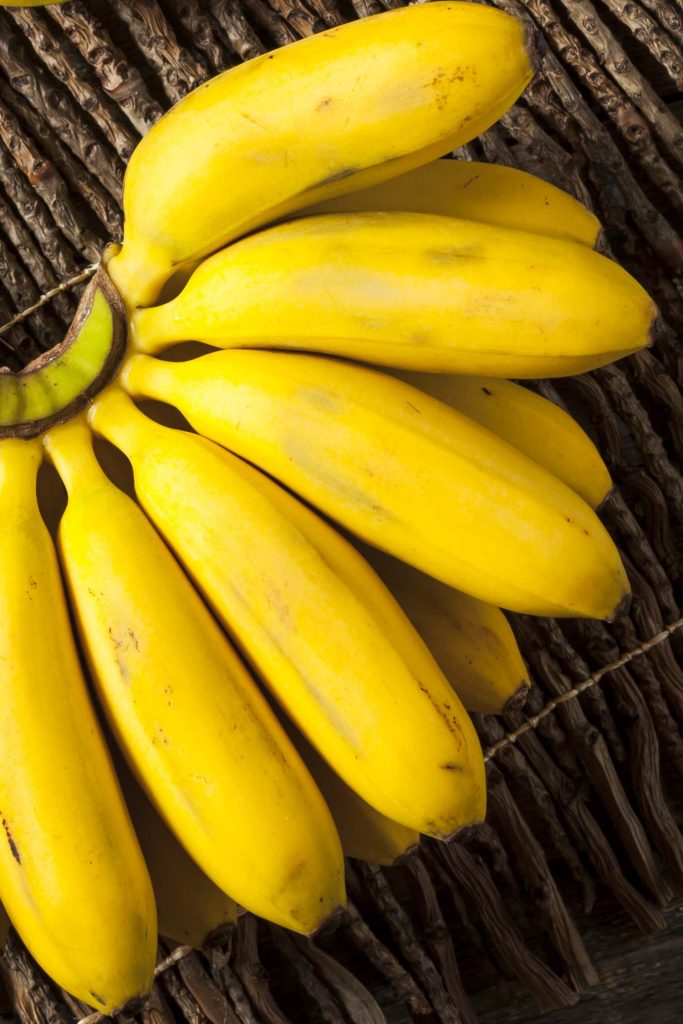
Banana Bocadillo
More popularly known as lady finger bananas, banana bocadillos are sweet, small bananas that are native to Southeast Asia and one of the most delicious Filipino fruits.
They also known as pisang susu or milk banana fruits in Bali.
But this Colombian fruit is now grown in South American countries as well. Banana bocadillos are available all year round.
We might call them baby bananas. They are eaten as a snack or dessert for their sweet and tart flavor, thus the name sugar bananas.
These exotic tropical fruits are also added to fruit salad, banana pudding and banana bread.
Banana bocadillos are also used to make bananas foster in Colombia and because of their health benefits. Some locals peel and freeze them. You can make smoothies with these since they can last for up to 3 months when frozen.
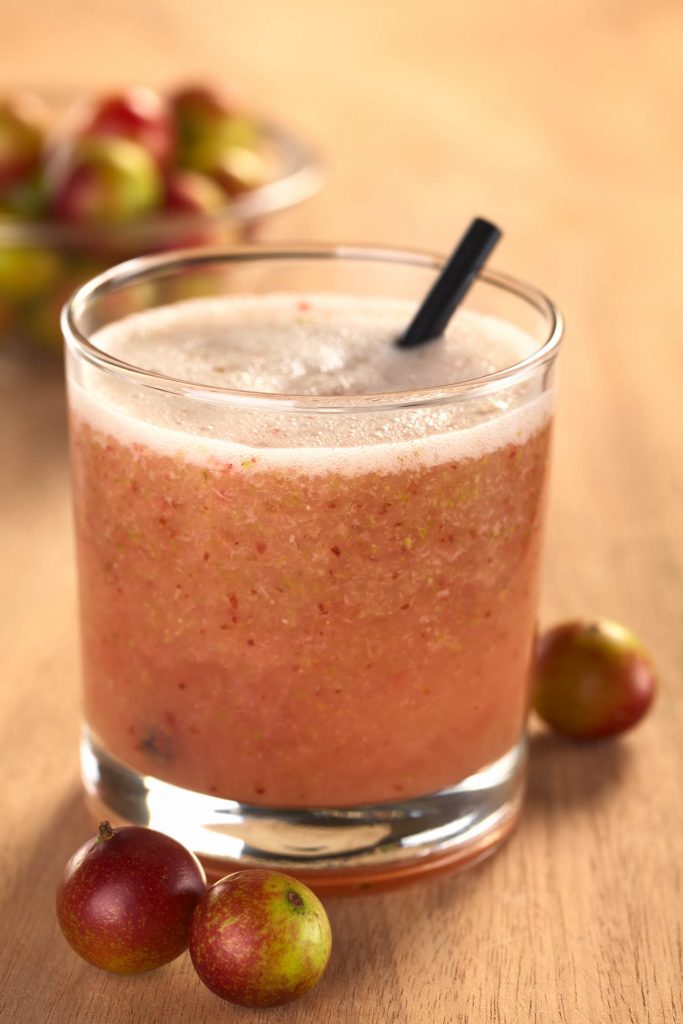
Camu camu
Camu camu is giving acai a run for its money in terms of health benefits.
Native to the Amazon rainforests of Brazil, Colombia, Peru and Venezuela, this exotic fruit contains 60 times more vitamin C than a serving of orange. It’s also a natural energy booster.
As one of the best Colombian fruits, locals eat the camu camu fruit. Although it can be very sour and acidic.
Some also extract its juice. They mix it with sugar to be made into a pink drink that’s similar to lemonade.
Camu camu seeds are also now being roasted and the pulp is made into ice cream and desserts.
Corozo
The fruit of the now endangered corozo palm. It is cultivated in the Cordoba and Bolivar regions of Colombia.
Corozo is a small, purple, sour fruit that’s usually made into juice and wine in the areas where it’s grown. It’s also a popular street drink.
Colombian Street Food
Unlike other exotic tropical fruits, corozo can only be found in the Caribbean parts of the country. The Colombian town of Sucre holds an annual festival to honor this humble fruit.
Papayuela
Native to the Andes regions of South America including Colombia, papayuela or mountain papaya is named as such because it looks like the smaller version of your regular papaya.
But when you cut this fruit in half, you’ll see its white pulp with black seeds. Papayuela is a green fruit that turns yellow when fully ripe. It can be eaten raw because it is sweet and tangy.
In Colombia, this fruit is made into dulce de papayuela. This is a jam that’s used as a spread or sweetener to some Colombian dishes.
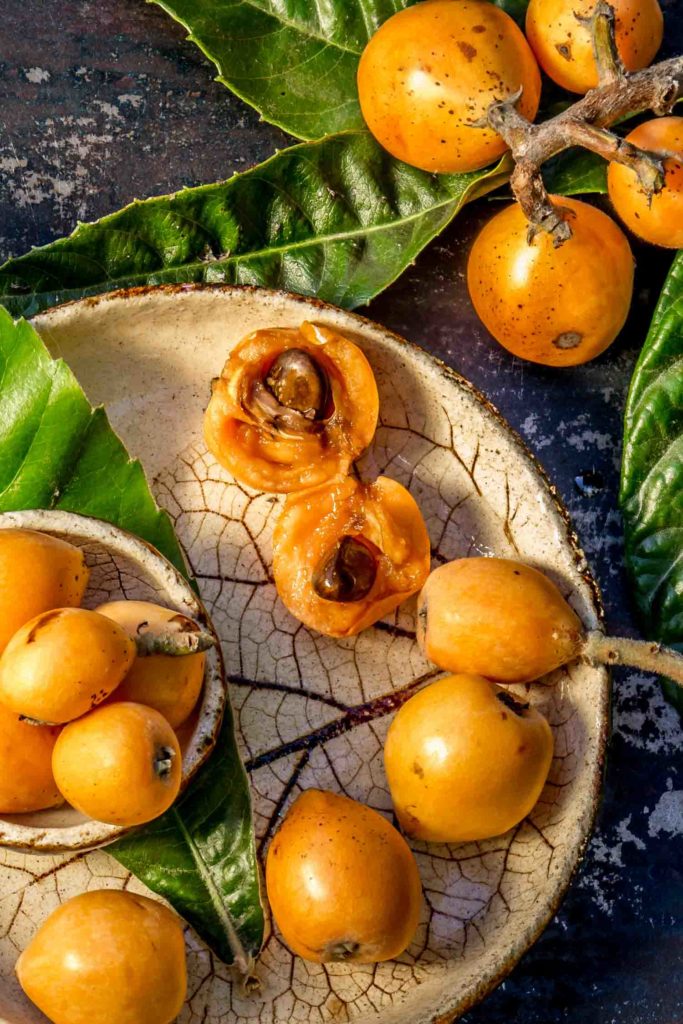
Nispero
Another fruit in Colombia that’s highly revered for its health benefits is nispero or loquat.
It is native to the Caribbean, Mexico and Central America, nispero is known for being an odd-looking fruit with its rough, brown skin.
But when you open this large berry, the nispero’s flesh actually looks like a ripe pear. It has a grainy texture and yellow colour.
Locals usually eat nispero raw because of its sweet and tart flavour. But it can also be made into a jam, relish, juice or smoothie.
Nispero leaves are also now being studied for its possible cancer-fighting properties.
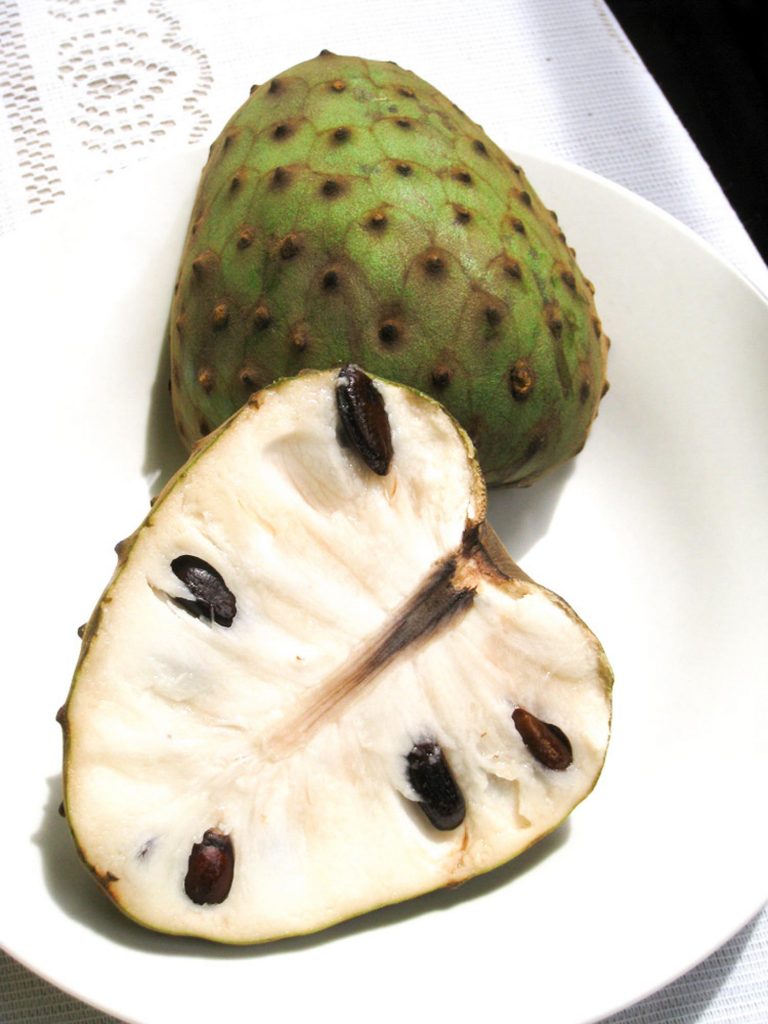
Annona
More popularly known as sugar apple or cherimoya, the origins of annona is unknown. But it’s widely cultivated in South American countries like Colombia.
Or head to the Caribbean as it’s a common Cuban fruit.
As one of the more popular exotic tropical fruits, annona is a heart-shaped green fruit with unique protuberances on its skin.
When you cut the fruit in half, you’ll see a white pulp with black seeds.
Annona is traditionally eaten raw with its seeds spit out after sucking the sweet pulp.
The juice is also extracted from the pulp and added to smoothies, ice cream and other desserts.
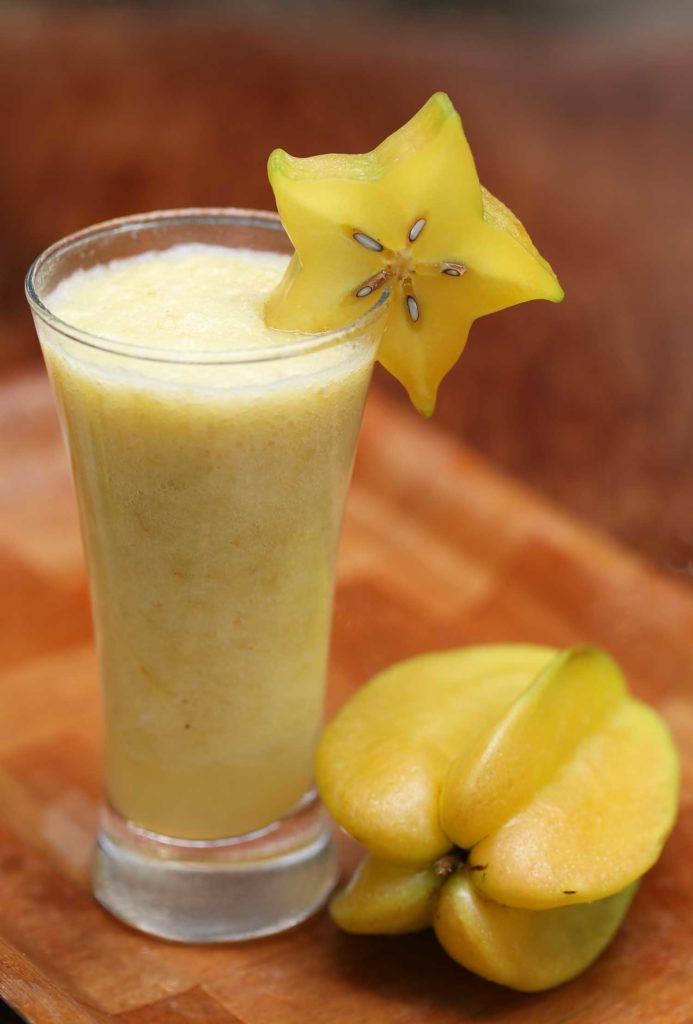
Carambola
Also known as star fruit, carambola got its name from its five-pointed star shape that’s more prevalent when it’s cut in half.
Carambola traces its origins in Southeast Asia. But it’s now cultivated in South America, the Caribbean and a common Guatemalan fruit.
This fruit in Colombia is highly acidic and it resembles the flavour profile of pineapples, plums and lemons.
Carambola is usually just salted and eaten raw with its skin and seeds. It is quite juicy and crunchy like an unripe mango.
It is also versatile enough to be made into pickles, jams and even used in cooking different Colombian dishes.
However, people suffering from kidney problems shouldn’t eat carambola. Its neurotoxin content means that damaged kidneys won’t be able to filter out of the body.
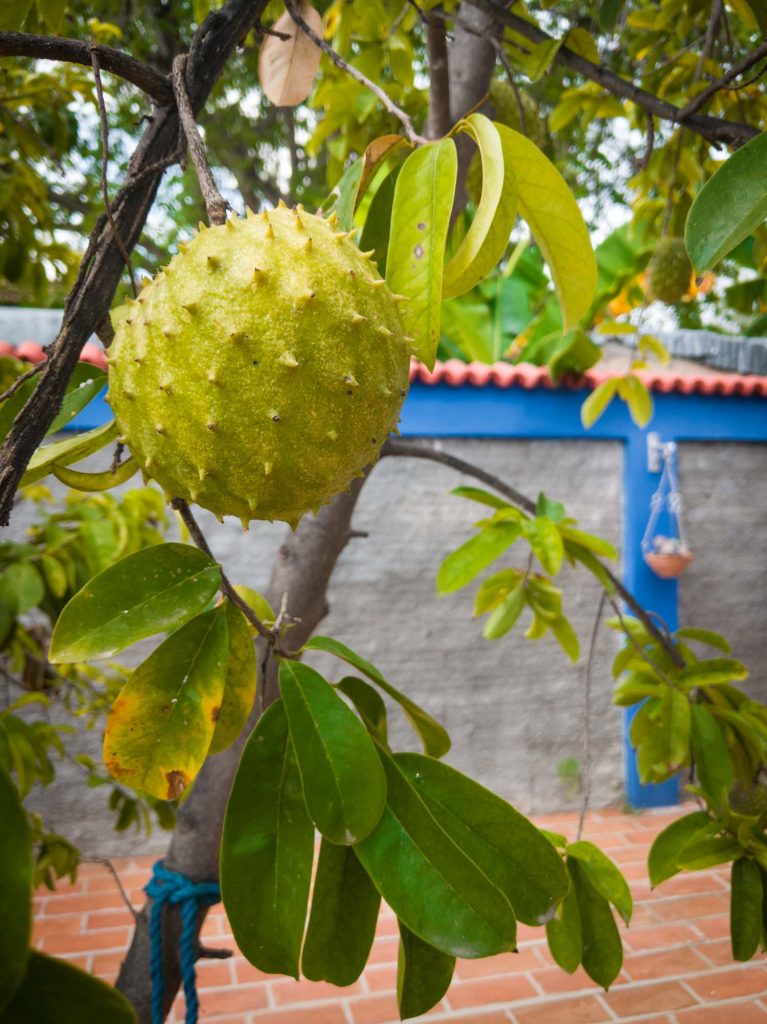
Guanabana
Guanabana or soursop is widely known as one of Colombia’s tropical exotic fruits because of its odd-looking skin that’s filled with tiny spikes.
But guanabana offers a lot of health benefits including its high antioxidant content that’s believed to help treat cancer.
In Colombia, guanabana is available all year-round. It is widely consumed for its soft, white, sweet pulp that has the same texture as custard.
This fruit has a similar flavour profile as a pineapple or banana. Aside from being eaten raw, guanabana is also made into shakes, juices, smoothies and desserts.
You can also find it now in South East Asia and it’s a common Cambodia fruit and fruit in Laos.
Uchuvas
Popularly called as the love fruit in Peru, uchuvas is known in Colombia as the golden berry because of its bright yellow color.
As one of the most popular fruits in Colombia, you can find boxes of these tiny fruits in food markets where you’ll easily notice them because of their paper wrapping.
Also known as gooseberries, uchuvas are actually harvested with a natural outer layer that resembles paper when dried out.
Uchuvas is generally tart and sweet, and they tend to be a lot sweeter as they ripen.
Aside from being eaten raw, Colombians add uchuvas into their salads. They are also used for jams, jellies, sauces and even a local gin and tonic.
They have reached beyond South America to South East Asia and are now common fruits in Thailand.
Gulupa
Belonging to the same passion fruit family as maracuya, gulupa is different from the latter because of its reddish-purple skin that becomes wrinkled when the fruit is fully ripe.
It’s often called the purple passion fruit or passiflora edulis.
When cut in half, gulupa’s flesh looks exactly the same as other passion fruits with its yellow pulp and small black seeds.
Locals usually eat gulupa by scooping the flesh out with the spoon. Its combination of sweet and sour flavours makes this fruit perfect for smoothies and juices.
It also contains a good amount of vitamin C, making it a very healthy choice for those who love exotic tropical fruits in Colombia.
Pin it: Fruits in Colombia
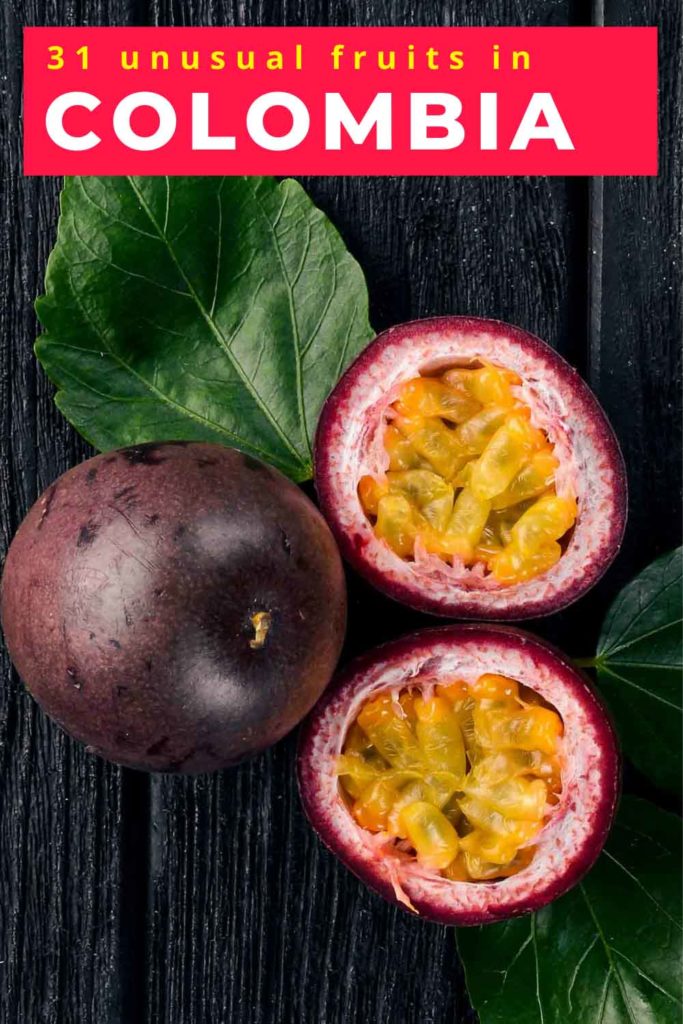
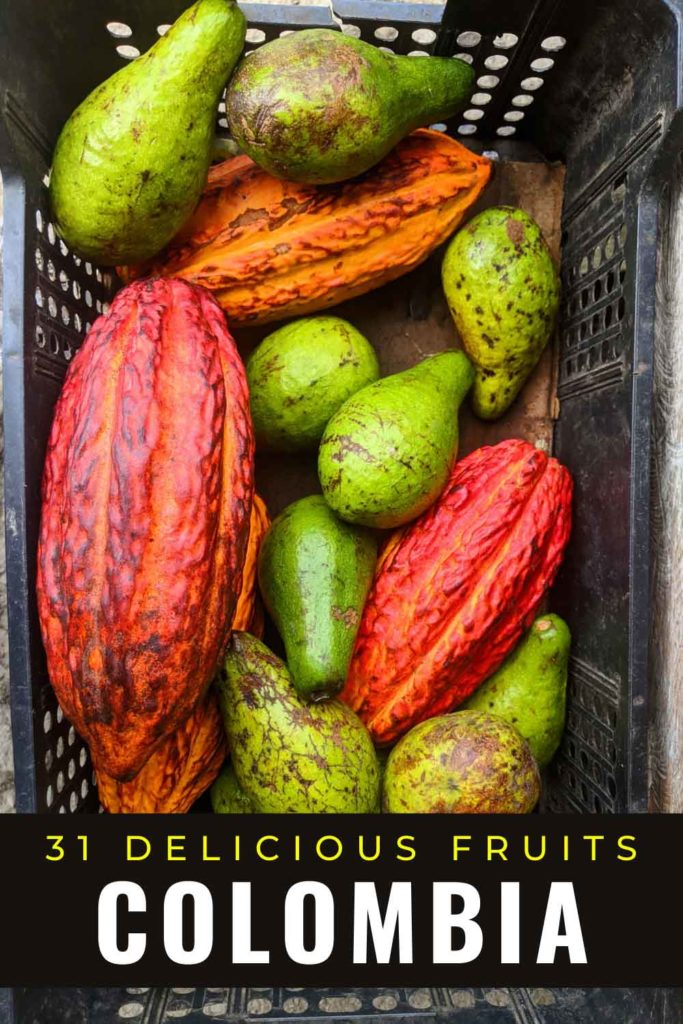
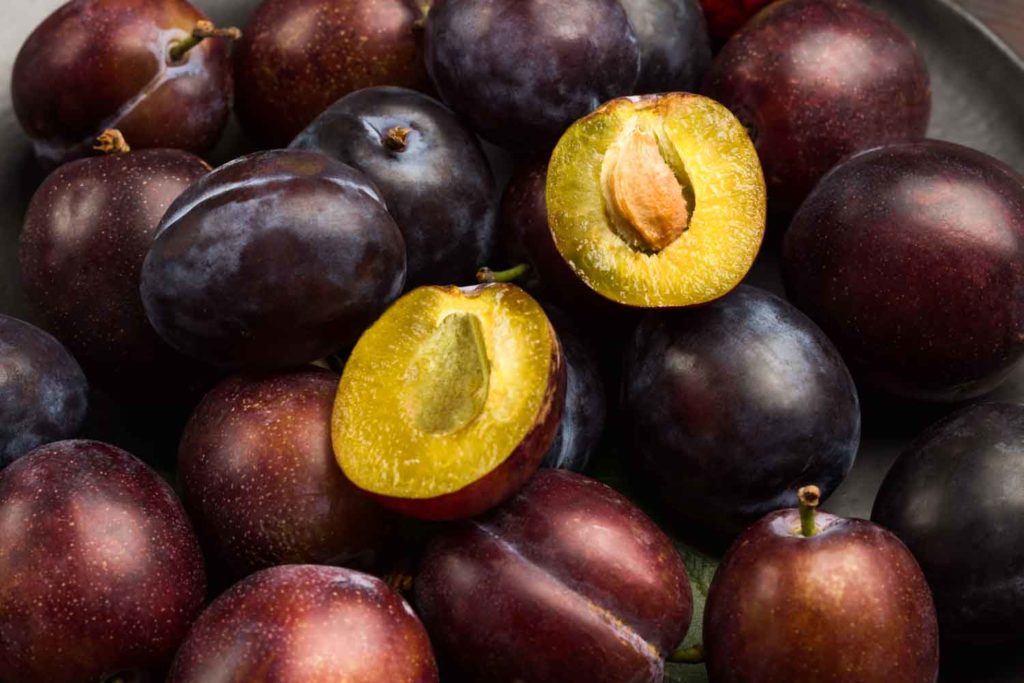
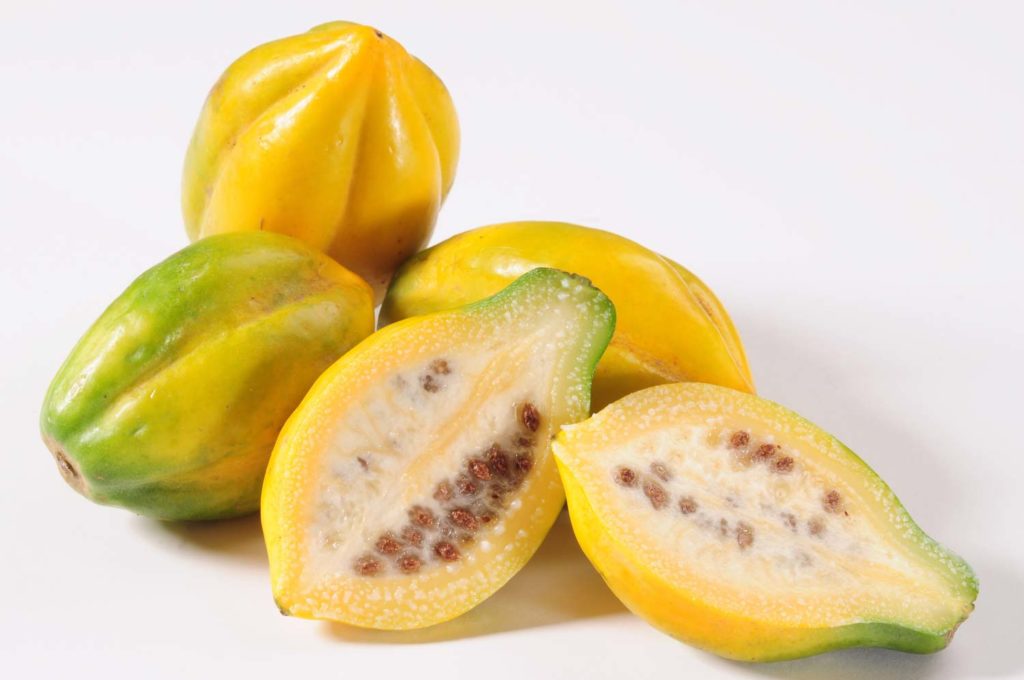
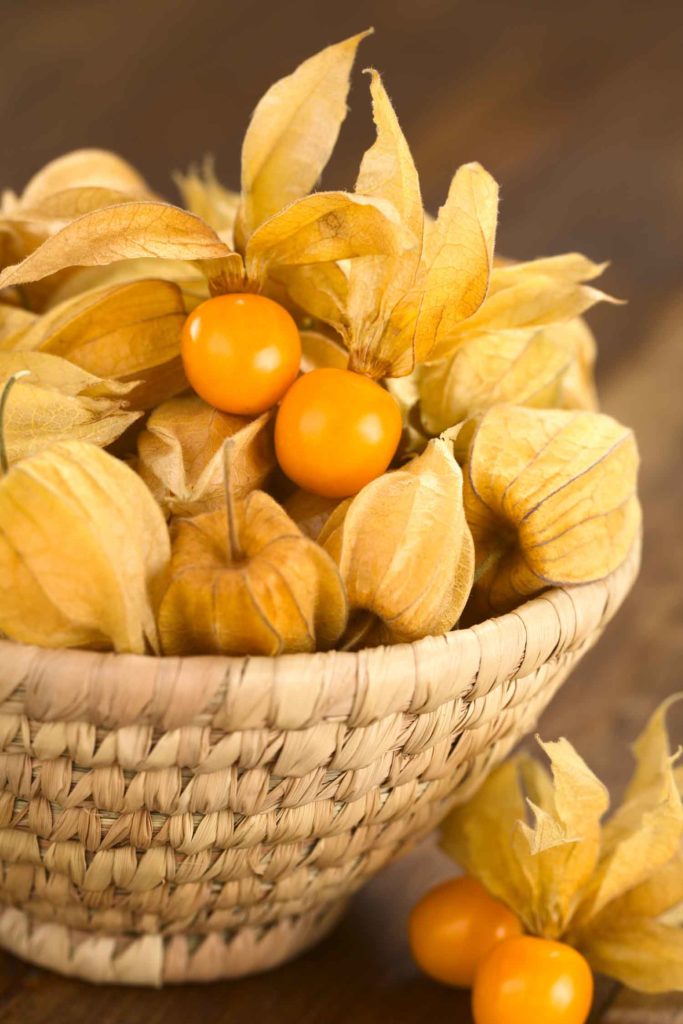
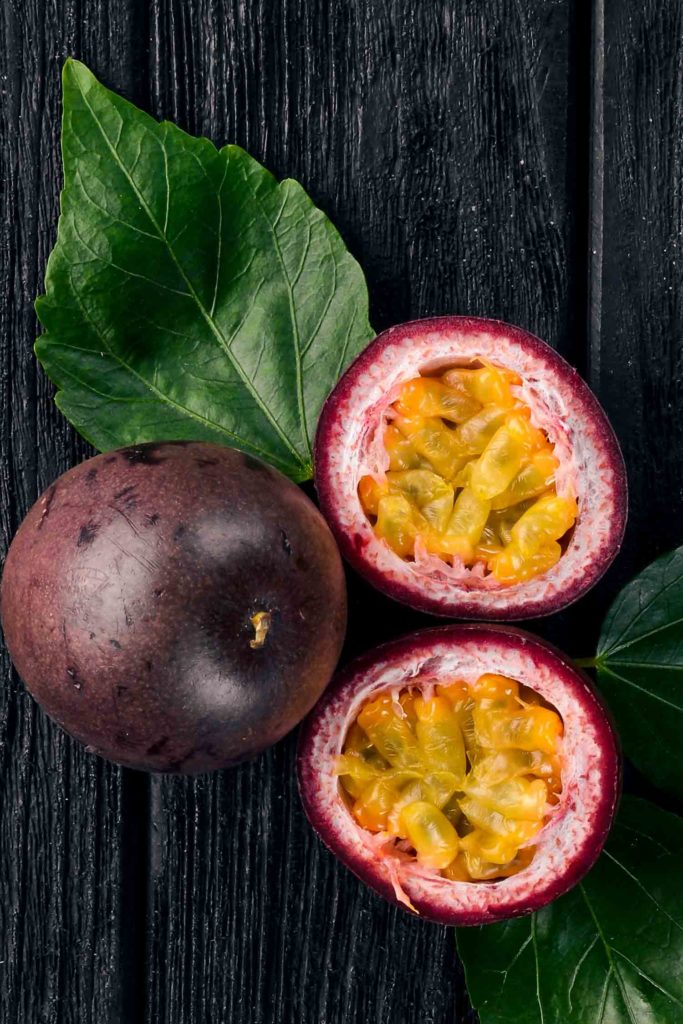
I’m curious to why they call the Colombian banana Habana ?